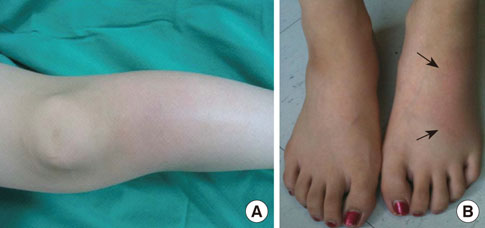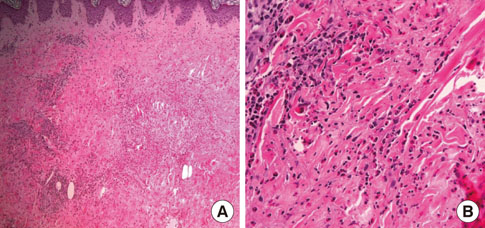Allergy Asthma Immunol Res.
2013 Jan;5(1):62-64. 10.4168/aair.2013.5.1.62.
Successful Treatment of Steroid-Dependent Eosinophilic Cellulitis With Cyclosporine
- Affiliations
-
- 1Department of Pediatrics, Inje University Sanggye Paik Hospital, Seoul, Korea. hbkim@paik.ac.kr
- 2Department of Pathology, Ajou University College of Medicine, Suwon, Korea.
- KMID: 2167009
- DOI: http://doi.org/10.4168/aair.2013.5.1.62
Abstract
- Eosinophilic cellulitis (EC) is a rare idiopathic disorder, first described as a "recurrent granulomatous dermatitis with eosinophilia", that mimics cellulitis of infectious origin. We describe here a previously healthy 11-year-old girl who experienced fever and tender erythematous patch lesions after trauma to her knees. Because of the relapsing cellulitis-like skin lesions, skin biopsies were taken, resulting in a diagnosis of EC. The patient responded well to oral prednisolone but experienced side effects and relapse during dose tapering. She was switched from prednisolone to cyclosporine. Her EC remained under control, and she showed no evidence of relapse after discontinuation of cyclosporine.
Keyword
MeSH Terms
Figure
Reference
-
1. Wells GC, Smith NP. Eosinophilic cellulitis. Br J Dermatol. 1979. 100:101–109.2. Moossavi M, Mehregan DR. Wells' syndrome: a clinical and histopathologic review of seven cases. Int J Dermatol. 2003. 42:62–67.3. Ladoyanni E, Vlachou C, Thushara R, Snead D. A patient with Wells' syndrome. Clin Exp Dermatol. 2010. 35:e3–e4.4. Kim HS, Kang MJ, Kim HO, Park YM. Eosinophilic cellulitis in a patient with gastric cancer. Acta Derm Venereol. 2009. 89:644–645.5. Moon HS, Park K, Lee JH, Son SJ. Eosinophilic cellulitis in an infant. Int J Dermatol. 2010. 49:592–593.6. Gandhi RK, Coloe J, Peters S, Zirwas M, Darabi K. Wells syndrome (eosinophilic cellulitis): a clinical imitator of bacterial cellulitis. J Clin Aesthet Dermatol. 2011. 4:55–57.7. Weiss G, Shemer A, Confino Y, Kaplan B, Trau H. Wells' syndrome: report of a case and review of the literature. Int J Dermatol. 2001. 40:148–152.8. Swartz MN. Clinical practice. Cellulitis. N Engl J Med. 2004. 350:904–912.9. España A, Sanz ML, Sola J, Gil P. Wells' syndrome (eosinophilic cellulitis): correlation between clinical activity, eosinophil levels, eosinophil cation protein and interleukin-5. Br J Dermatol. 1999. 140:127–130.10. Herr H, Koh JK. Eosinophilic cellulitis (Wells' syndrome) successfully treated with low-dose cyclosporine. J Korean Med Sci. 2001. 16:664–668.11. Hess AD, Esa AH, Colombani PM. Mechanisms of action of cyclosporine: effect on cells of the immune system and on subcellular events in T cell activation. Transplant Proc. 1988. 20:29–40.12. Teixeira MM, Williams TJ, Hellewell PG. Effects of dexamethasone and cyclosporin A on the accumulation of eosinophils in acute cutaneous inflammation in the guinea-pig. Br J Pharmacol. 1996. 118:317–324.
- Full Text Links
- Actions
-
Cited
- CITED
-
- Close
- Share
- Similar articles
-
- Eosinophilic Cellulitis (Wells' Syndrome) Successfully Treated With Low-dose Cyclosporine
- A Case of Bullous Eosinophilic Cellulitis
- A Case of Eosinophilic Cellulitis in a Child
- A Case of Eosinophilic Cellulitis in an 8-year-old Child
- Clinical and Histological Features of Eosinophilic Cellulitis in Korean Patients: A Case Series and Literature Review



